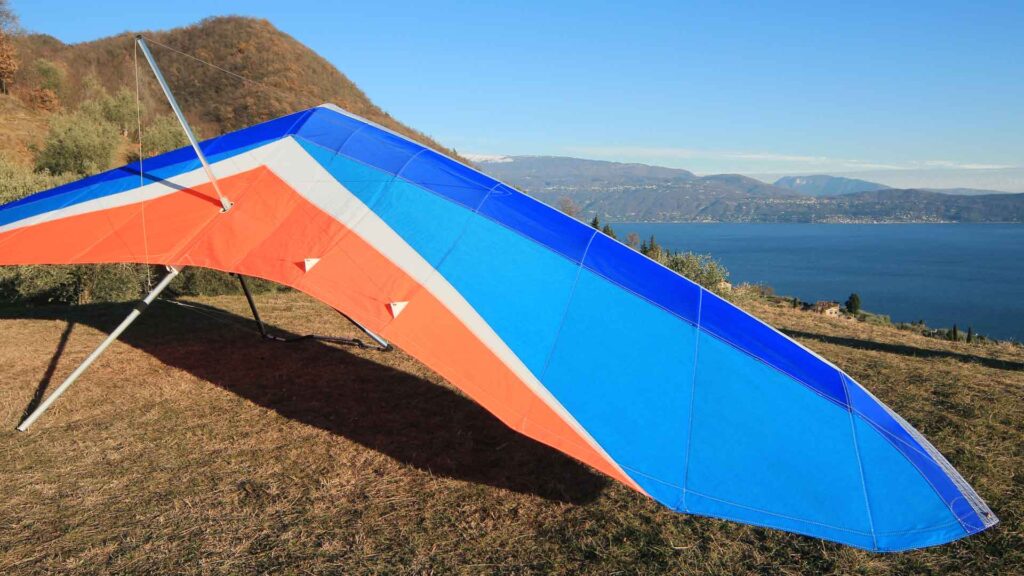The weight of a hang glider varies, but on average, it typically falls between 45 to 90 pounds (20 to 41 kilograms). This weight includes the glider’s frame, fabric, and any additional equipment. The design and materials used influence the overall weight. A lighter hang glider offers increased maneuverability, while a heavier one provides more stability.
Pilots must stay within the specified weight limits to ensure safe and effective flight. Weighing procedures are employed to determine the precise weight, and these factors are fundamental for those engaging in hang gliding, contributing to a safer and more enjoyable experience in the skies.
What Determines Hang Glider Weight?

The weight of a hang glider is primarily determined by factors such as its size, wing area, frame material, sail composition, and additional equipment. The careful balance of these elements influences the glider’s overall weight, impacting its performance, stability, and responsiveness during flight.
Factors influencing the overall weight
Size and Wing Area: The size and wing area of a hang glider significantly impact its weight. Larger gliders, designed for increased lift and stability, tend to be heavier. The size plays a crucial role in determining how the glider interacts with air currents during flight.
Frame Material: The frame’s material is a critical factor in hang glider weight. Most modern gliders use lightweight materials like aluminum alloys. These materials offer a balance between strength and weight, ensuring structural integrity without unnecessary heaviness.
Sail Material: The sail, made from materials like Mylar or Dacron, influences the glider’s weight. These synthetic fabrics are chosen for their lightweight nature, providing durability without compromising aerodynamics. The sail’s design also affects weight distribution and performance.
Keel and Control Frame: The keel and control frame contribute to the glider’s weight, impacting its maneuverability and responsiveness. Innovative designs aim to optimize these components, using materials that offer both strength and reduced mass.
Additional Equipment: The weight of additional equipment, such as harnesses, instruments, and safety gear, is a consideration for pilots. While these accessories enhance the flying experience and safety, they add to the overall weight. Pilots often make choices based on their preferences and the specific requirements of their flights.
Materials used in hang glider construction
Aluminum Alloy: Aluminum alloys are commonly used for the frame of hang gliders. These alloys strike a balance between strength and weight, providing a sturdy framework while keeping the overall glider relatively light.
Carbon Fiber: High-end hang gliders often incorporate carbon fiber into their construction. This material is exceptionally lightweight and strong, contributing to improved performance. While it offers advantages in weight reduction, it may increase the manufacturing cost of the glider.
Mylar and Dacron: Synthetic materials like Mylar and Dacron are favored for the sail. These materials are chosen for their lightweight properties, flexibility, and durability. They play a crucial role in shaping the aerodynamics of the glider.
Titanium: In strategic areas, titanium may be used due to its remarkable strength-to-weight ratio. Titanium components contribute to the overall structural integrity of the glider while minimizing additional mass.
How Does Weight Impact the Dynamics and Safety of Hang Gliding?
Weight has a big effect on hang gliding, shaping how the glider flies and how safe it is. Enthusiasts must grasp how weight influences things like lift, steering, and overall safety to make the most of their hang-gliding adventures
Why weight is a critical factor in hang gliding
Aerodynamics and Lift
The weight of a hang glider plays a critical role in its aerodynamics. A glider’s ability to generate lift is closely tied to its weight. Heavier gliders typically require more lift to stay airborne, influencing takeoff and overall flight dynamics.
Performance and Maneuverability
Weight affects the overall performance and maneuverability of a hang glider. Lighter gliders are often more responsive to pilot input, allowing for agile turns and quick adjustments. Conversely, heavier gliders may provide stability but could be less nimble.
Launch and Landing
During launch, a glider’s weight influences the required speed for takeoff. Lighter gliders can achieve takeoff at lower speeds, while heavier gliders may need more momentum. Similarly, landing dynamics are impacted, with lighter gliders having a potentially gentler touch down.
Wind Conditions
Weight is a crucial factor in how a hang glider handles different wind conditions. Lighter gliders are more susceptible to being affected by turbulent winds, while heavier gliders may offer more stability but could require greater pilot effort to control.
Effects of different weights on performance and safety

Glide Ratio and Speed
The weight of a hang glider influences its glide ratio—the distance it can travel horizontally compared to its descent. Lighter gliders often have higher glide ratios, allowing for more extended flights, while heavier gliders may descend more rapidly.
Weight-Shift Control
Pilots use weight-shift control to steer hang gliders. The weight of the glider and the pilot directly impacts how responsive the glider is to weight-shift inputs. Finding the right balance is crucial for precise control.
Safety Considerations
Weight is a critical safety consideration in hang gliding. Pilots must adhere to weight limits specified by manufacturers to ensure the glider’s structural integrity and safe operation. Exceeding these limits can compromise safety during flight.
Energy Efficiency
Lighter gliders require less energy to stay airborne, making them more energy-efficient. This can be advantageous for longer flights and in conditions where lift may be limited.
How to Determine the Weight of a Hang Glider?
To find out how much a hang glider weighs, pilots use special scales designed for this purpose. They make sure the weight is spread evenly and sometimes use portable weighing stations.
Weighing procedures and equipment
Utilizing Hang Scales
Hang gliders are typically weighed using specialized hang scales designed for accurate measurements. These scales are strategically positioned to lift the glider off the ground, allowing for precise weight determination.
Distributing Weight Evenly
Weighing procedures involve ensuring that the weight is distributed evenly across the glider. This includes accounting for any additional equipment, such as harnesses or instruments, to provide a comprehensive measurement of the entire flying setup.
Portable Weighing Stations
Portable weighing stations are commonly used in hang gliding communities. These stations are designed for easy transport to different flying sites, enabling pilots to assess their glider’s weight before each flight for optimal performance.
Importance of accurate measurements
Performance Optimization
Accurate weight measurements are crucial for optimizing the performance of the hang glider. Pilots can make informed decisions about equipment choices and adjustments based on precise weight data, contributing to more efficient flights.
Adherence to Manufacturer Guidelines
Manufacturers provide specific weight limits for each hang glider model. Accurate measurements ensure pilots adhere to these guidelines, promoting safe operation and preserving the structural integrity of the glider as per the manufacturer’s specifications.
Glide Ratio Calculations
The glide ratio, a key performance metric, is directly influenced by the accurate weight of the glider. Pilots can calculate and anticipate glide ratios more effectively when armed with precise weight measurements, enhancing their ability to navigate varying flying conditions.
Safety Assurance
Accurate weight measurements contribute to overall safety. Pilots can confidently operate within specified weight limits, minimizing the risk of unexpected behavior during flight and ensuring a stable and secure flying experience.
Equipment Longevity
Knowing the accurate weight of the hang glider aids in preserving the longevity of the equipment. Pilots can make informed choices regarding additional gear, keeping the total weight within recommended limits to reduce stress on the glider’s components.
Compliance with Regulations
Accurate weight measurements ensure compliance with aviation regulations and standards. Whether for recreational or competitive flying, meeting these standards is essential for the pilot’s legal standing and the overall safety of the hang gliding community.
Personalized Setup
Pilots often customize their hang gliding setups based on accurate weight data. This personalized approach allows them to fine-tune the glider’s characteristics to match their flying style, providing a more tailored and enjoyable experience.
Different Hang Glider Models And Their Weights
| Hang Glider Model | Description/Features | Weight | Website |
| Airwave Hang Glider | Beginner-friendly, low stall speed, easy to fly | 45 pounds | Airwave |
| Ozone Delta 2 Hang Glider | Advanced, stable, suitable for thermals | 55 pounds | Ozone Delta 2 |
| Advance Epsilon 8 Hang Glider | High-performance, fast, maneuverable | 60 pounds | Advance Epsilon 8 |
| Niviuk Icaro Hang Glider | Tandem, designed for flying with a passenger | 90 pounds | Niviuk Icaro |
| Flow Hang Glider | Inflatable, easy to transport and set up | 15 pounds | Flow |
FAQ
How much does a powered hang glider weigh?
Powered hang gliders typically weigh between 450 to 600 pounds, depending on the model and additional features.
How much does a hang glider cost?
Hang glider costs vary but generally range from $3,000 to $10,000 for a new glider. Used ones may be more budget-friendly.
Is there a weight limit on hang gliding?
Yes, weight limits for hang gliding depend on the specific glider and its design. Most have weight limits ranging from 200 to 300 pounds.
What is the death ratio for hang gliding?
Hang gliding has a low fatality rate, with an estimated 1 in 116,000 flights resulting in a fatal accident. Proper training and adherence to safety guidelines are crucial.
What is too heavy for gliding?
Exceeding the weight limit specified by the hang glider’s manufacturer is unsafe. It can affect performance and compromise safety during flight.
What are the dangers of hang gliding?
While hang gliding is generally safe, risks include pilot error, weather conditions, and equipment issues. Proper training, maintenance, and adherence to safety protocols mitigate these risks.
How hard is it to hang glide?
Learning to hang glide requires dedication and training. Most beginners can start flying solo after 10 to 20 lessons, but continuous practice enhances skills.
Are glider rides safe?
Yes, glider rides are generally safe when conducted by experienced and certified pilots. Passengers enjoy breathtaking views with safety as a top priority.
Which is safer, hang glider or paraglider?
Both hang gliders and paragliders are safe when operated responsibly. The choice depends on personal preference, as hang gliders offer more speed, while paragliders provide a slower, more leisurely experience.
How fast can a glider fly?
Hang gliders can reach speeds of 18 to 60 miles per hour, depending on factors like wind conditions and the glider’s design. Experienced pilots can control speed with ease.
Final words
To wrap up, understanding how much a hang glider weighs is essential for any enthusiast. The weight impacts how it flies, its responsiveness, and overall performance. Pilots must consider their skill level, flying environment, and personal preferences when choosing a hang glider within the appropriate weight range. Striking this balance ensures a smoother, safer, and more enjoyable experience in the skies. So, whether you’re a beginner or an experienced pilot, the right weight choice is key to soaring through the air with confidence and control.

